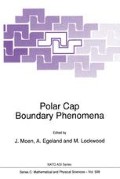Abstract
We review and summarize the evidence that a closed LLBL exists, at least away from noon. We also emphasize the observation that just equatorward of the LLBL, overlapping magnetosheath and magnetospheric electrons exist on sunward convecting field lines which have no low-energy ion cutoff (i.e., closed field lines). Therefore it is inescapable to conclude that sheath plasma is introduced onto closed field lines. The dropoff of the high-energy electrons is identified not necessarily with the open/closed boundary but rather with the convection reversal boundary, since these electrons originate on the nightside and convect towards the dayside (hence they cannot exist on anti-sunward convecting field lines, even if the latter are closed). A model is discussed wherein diffusion introduces sheath plasma onto closed field lines, but merging removes these same field lines from the dayside. The competition between these two effects explains why the LLBL is thinnest at noon, where open LLBL signatures dominate (perhaps exclusively), and why the LLBL is thicker for northward IMF.
Access this chapter
Tax calculation will be finalised at checkout
Purchases are for personal use only
Preview
Unable to display preview. Download preview PDF.
References
Rosenbauer, H., H. Grunwaldt, M. D. Montgomery, G. Paschmann, and N. Sckopke (1975) J. Geophys. Res., 80, 2723.
Eastman, T. E., E. W. Hones, S. J. Bame, and J. R. Asbridge (1976) Geophys. Res. Let., 3, 685.
Haerendel, G., G. Paschmann, N. Sckopke, H. Rosenbauer, and P. C. Hedgecock (1978) J. Geophys. Res., 83, 3195.
Eastman, T. E., B. Popielawska, and L. A. Frank (1985) J. Geophys. Res., 90, 9519.
Sanchez, E. R., and G. L. Siscoe (1990) J. Geophys. Res., 95, 20771.
Mitchell, D. G., F. Kutchko, D. J. Williams, T. E. Eastman, L. A. Frank, and C. T. Russell (1987) J. Geophys. Res., 92, 7394.
Fuselier, S. A, B. J. Anderson, and T. G. Onsager (1995) J. Geophys. Res., 100, 11805.
Lockwood, M., and J. Moen (1996) Geophys. Res. Lett., 23, 2895.
Lockwood, M., W. F. Denig, A. D. Farmer, V. N. Davda, S. W. H. Cowley, and H. Lühr (1993) Nature, 361, 424.
Newell, P. T., and C.-I. Meng (1995) J. Geophys. Res., 100, 21943.
Yamauchi, M., J. Woch, R. Lundin, M. Shapshak, R. Elphinstone (1993) Geophys Res. Lett., 20, 795.
Formisano, V. (1980) Planet. Space Sci., 28, 245.
Newell, P. T., W. J. Burke, E. R. Sánchez, C.-I. Meng, M. E. Greenspan, and C. R. Clauer (1991) J. Geophys. Res., 96, 21013.
Clemmons, J. H., C. W. Carlson, and M. H. Boehm (1995) J. Geophys. Res., 100, 12133.
Onsager, T. G., C. A. Kletzing, J. B. Austin, and H. MacKiernan (1993) Geophys. Res. Lett., 20, 479.
Wing, S., P. T. Newell, and T. G. Onsager (1996) J. Geophys. Res., 101, 13155.
Newell, P. T., S. Wing, C.-I. Meng, and V. Sigillito (1991) J. Geophys. Res., 96, 5877.
Alem, F. and D. C. Delcourt (1995) J. Geophys. Res., 100, 19321.
Sergeev, V. A., G. R. Bikkuzina, and P. T. Newell (1997) Annales. Geophys.
Grande, M., J. Fennell, S. Livi, B. Kellett, C. H. Perry, P. Anderson, J. Roeder, H. Spence, T. Fritz, and B. Wilken (1997) Geophys Res. Lett., 24.
Woch, J., and R. Lundin (1992) J. Geophys. Res., 97, 1421.
Omidi, N., and D. Winske (1995) J. Geophys. Res., 100, 11935.
Author information
Authors and Affiliations
Editor information
Editors and Affiliations
Rights and permissions
Copyright information
© 1998 Springer Science+Business Media Dordrecht
About this chapter
Cite this chapter
Newell, P.T., Meng, CI. (1998). Open and Closed Low Latitude Boundary Layer. In: Moen, J., Egeland, A., Lockwood, M. (eds) Polar Cap Boundary Phenomena. NATO ASI Series, vol 509. Springer, Dordrecht. https://doi.org/10.1007/978-94-011-5214-3_8
Download citation
DOI: https://doi.org/10.1007/978-94-011-5214-3_8
Publisher Name: Springer, Dordrecht
Print ISBN: 978-94-010-6195-7
Online ISBN: 978-94-011-5214-3
eBook Packages: Springer Book Archive

